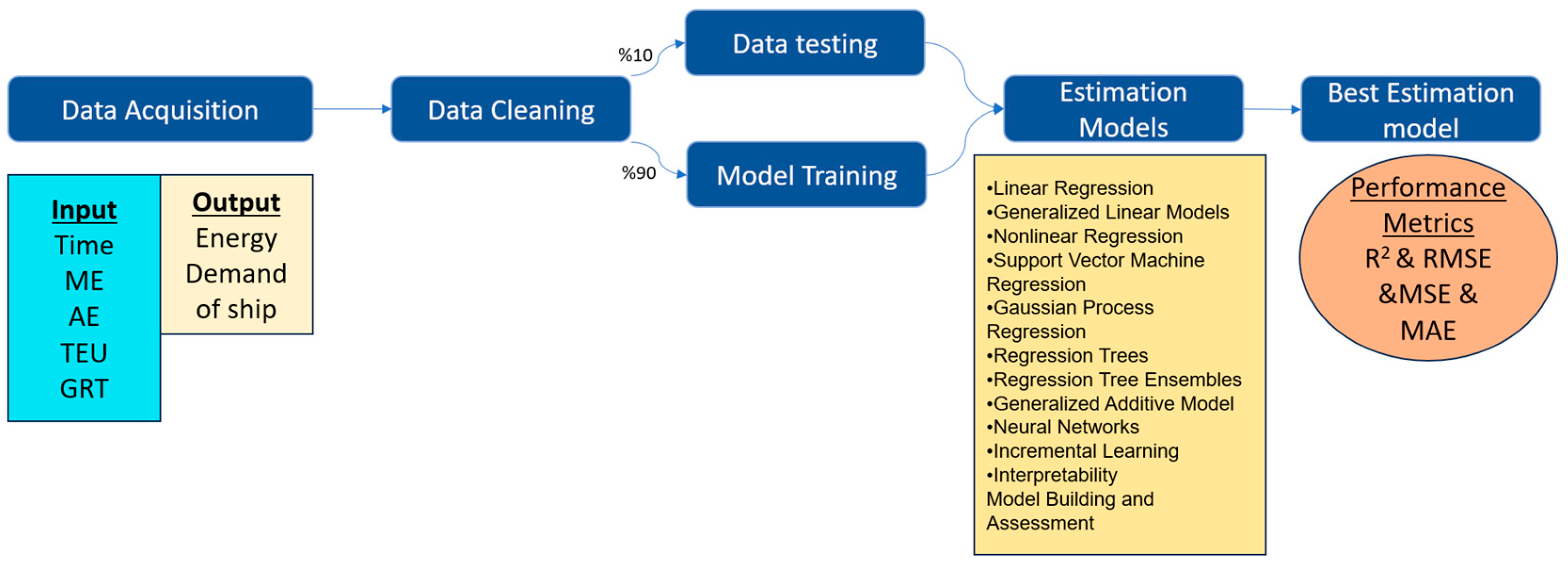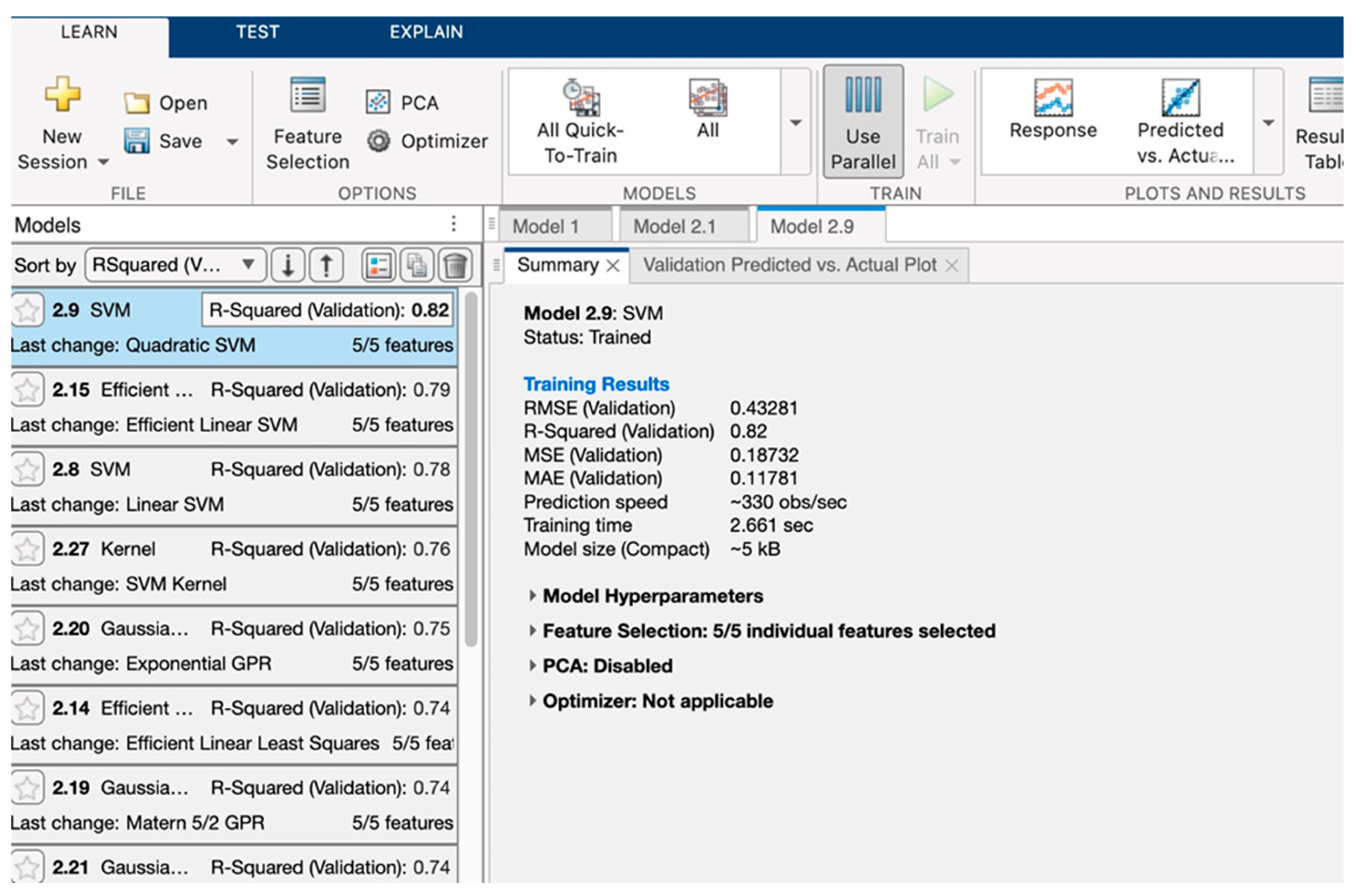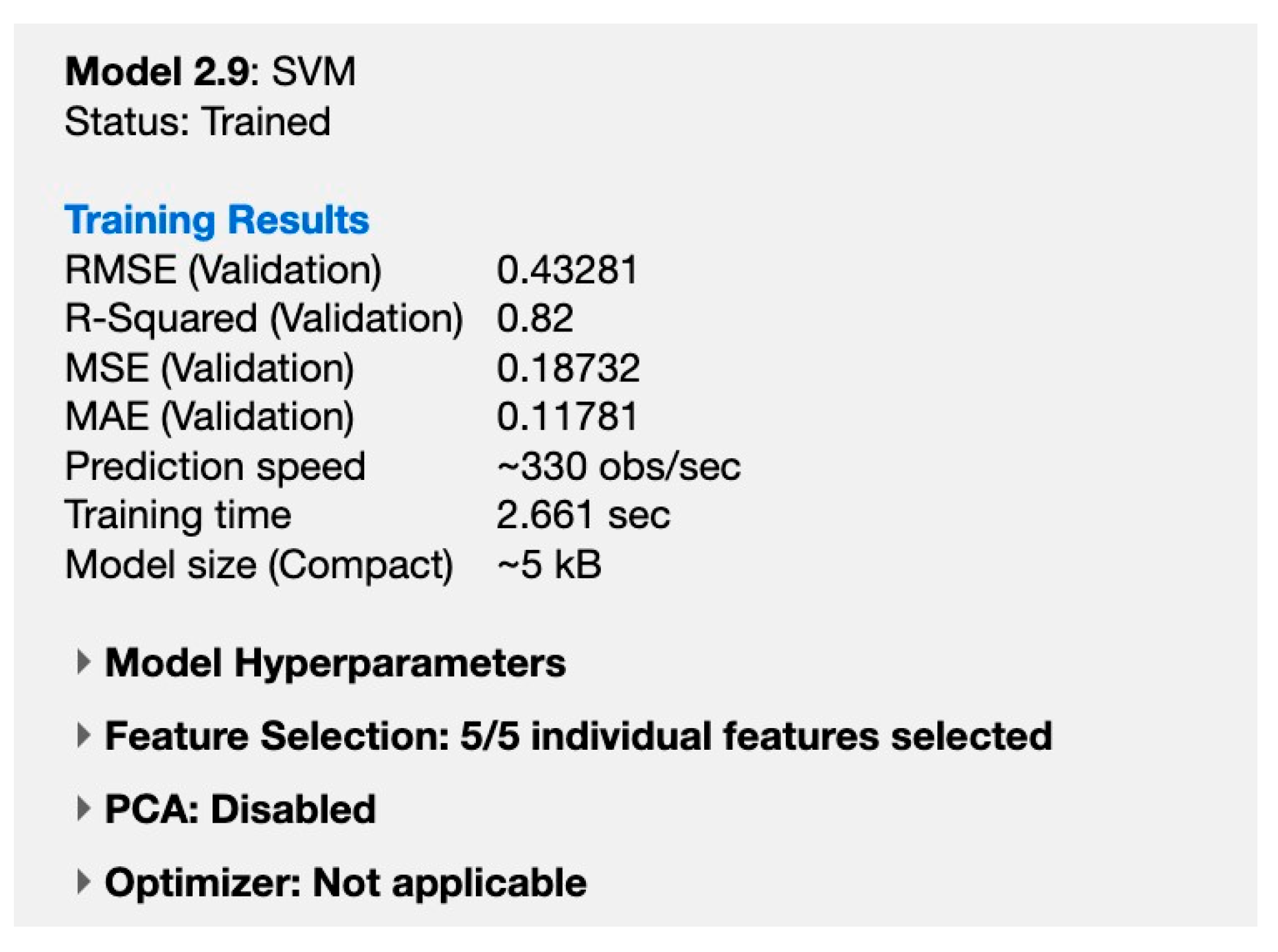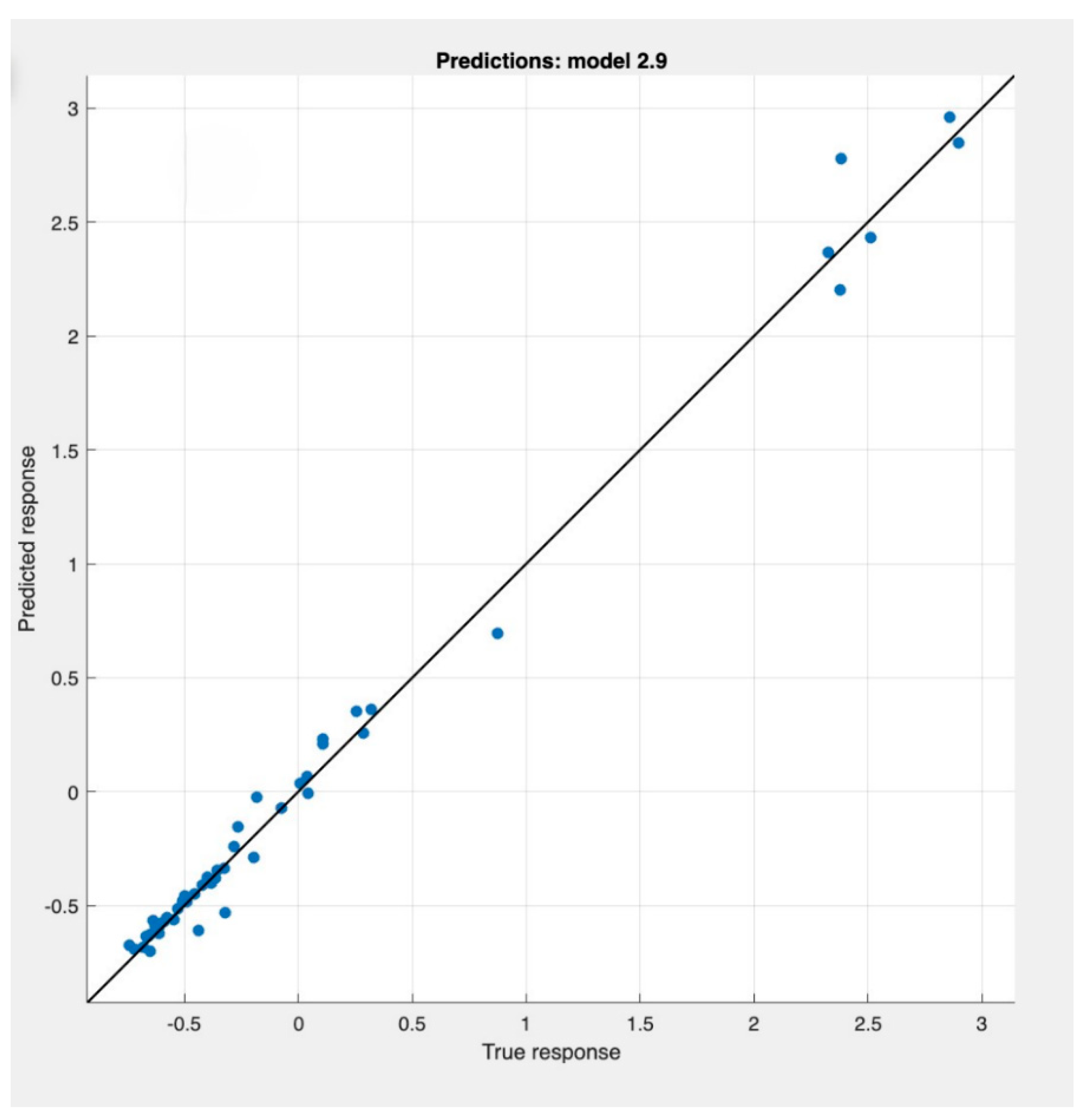A Novel Study for Machine-Learning-Based Ship Energy Demand Forecasting in Container Port
Abstract
1. Introduction
2. Literature Review
3. Data Collection
4. Methodology
4.1. Energy Demand of Ships in Port
4.2. Prediction Methodology
- −
- yfit: Estimated values to be found;
- −
- trainedModel: Exported regression model;
- −
- predictFcn: Predict command;
- −
- T: Data to be estimated.
5. Results
6. Discussion
7. Conclusions
Funding
Institutional Review Board Statement
Informed Consent Statement
Data Availability Statement
Conflicts of Interest
References
- Perčić, M.; Ančić, I.; Vladimir, N. Life-Cycle Cost Assessments of Different Power System Configurations to Reduce the Carbon Footprint in the Croatian Short-Sea Shipping Sector. Renew. Sustain. Energy Rev. 2020, 131, 110028. [Google Scholar] [CrossRef]
- Pérez Osses, J.R.; Palma, V.M.; Reusser, C.A. Emissions Assessment of a Tanker in a Chilean Port Using Bi-Directional Cold Ironing Integrated to LNG. Sustain. Energy Technol. Assess. 2022, 52, 102135. [Google Scholar] [CrossRef]
- UNCTAD. Review of Maritime Transport 2021; UN: New York, NY, USA, 2021; ISBN 9210000978. [Google Scholar]
- Weng, J.; Shi, K.; Gan, X.; Li, G.; Huang, Z. Ship Emission Estimation with High Spatial-Temporal Resolution in the Yangtze River Estuary Using AIS Data. J. Clean. Prod. 2020, 248, 119297. [Google Scholar] [CrossRef]
- Gray, N.; McDonagh, S.; O’Shea, R.; Smyth, B.; Murphy, J.D. Decarbonising Ships, Planes and Trucks: An Analysis of Suitable Low-Carbon Fuels for the Maritime, Aviation and Haulage Sectors. Adv. Appl. Energy 2021, 1, 100008. [Google Scholar] [CrossRef]
- Verschuur, J.; Koks, E.E.; Hall, J.W. Ports’ Criticality in International Trade and Global Supply-Chains. Nat. Commun. 2022, 13, 4351. [Google Scholar] [CrossRef]
- Dvorak, J.; Burkšienė, V. Sustainability Factors Shaping Port Security: A Case Study of Baltic Ports. In Global Challenges in Maritime Security: Sustainability and the Sea; Otto, L., Menzel, A., Eds.; Springer International Publishing: Cham, Switzerland, 2024; pp. 81–111. ISBN 978-3-031-59903-3. [Google Scholar]
- Wang, S.; Luo, Y.; Liu, Z.; Lu, B. Analysis on Energy Conservation and Emission Reduction Efficiency and Influencing Factors for Ports around Bohai in China under the Low Carbon Target. Sustainability 2022, 14, 14765. [Google Scholar] [CrossRef]
- Hua, C.; Chen, J.; Wan, Z.; Xu, L.; Bai, Y.; Zheng, T.; Fei, Y. Evaluation and Governance of Green Development Practice of Port: A Sea Port Case of China. J. Clean. Prod. 2020, 249, 119434. [Google Scholar] [CrossRef]
- Darbra Roman, R.M.; Wooldridge, C.; Puig Duran, M. ESPO Environmental Report 2020-EcoPortsInsights 2020; ESPO: Adelaide, SA, Australia, 2020. [Google Scholar]
- Bojić, F.; Gudelj, A.; Bošnjak, R. Port-Related Shipping Gas Emissions—A Systematic Review of Research. Appl. Sci. 2022, 12, 3603. [Google Scholar] [CrossRef]
- Manisalidis, I.; Stavropoulou, E.; Stavropoulos, A.; Bezirtzoglou, E. Environmental and Health Impacts of Air Pollution: A Review. Front. Public Health 2020, 8, 505570. [Google Scholar] [CrossRef]
- Allen, M.; Abdul Halim, S.; Antwi-Agyei, P.; Aragón-Durand, F.; Babiker, M.; Bertoldi, P.; Bindi, M.; Brown, S. Technical Summary. In: Global Warming of 1.5 °C. An IPCC Special Report on the Impacts of Global Warming of 1.5 °C Above Pre-Industrial Levels and Related Global Greenhouse Gas Emission Pathways, in the Context of Strengthening the Global Response to the Threat of Climate Change, Sustainable Development, and Efforts to Eradicate Poverty. Available online: https://www.ipcc.ch/site/assets/uploads/sites/2/2018/12/SR15_TS_High_Res.pdf (accessed on 19 March 2021).
- McPhaden, M.J.; Santoso, A.; Cai, W. Introduction to El Niño Southern Oscillation in a Changing Climate. In El Niño Southern Oscillation in a Changing Climate; John Wiley & Sons, Inc.: Hoboken, NJ, USA, 2020; pp. 1–19. [Google Scholar]
- Mamatok, Y.; Jin, C. An Integrated Framework for Carbon Footprinting at Container Seaports: The Case Study of a Chinese Port. Marit. Policy Manag. 2017, 44, 208–226. [Google Scholar] [CrossRef]
- Martínez-Moya, J.; Vazquez-Paja, B.; Gimenez Maldonado, J.A. Energy Efficiency and CO2 Emissions of Port Container Terminal Equipment: Evidence from the Port of Valencia. Energy Policy 2019, 131, 312–319. [Google Scholar] [CrossRef]
- Sadek, I.; Elgohary, M. Assessment of Renewable Energy Supply for Green Ports with a Case Study. Environ. Sci. Pollut. Res. 2020, 27, 5547–5558. [Google Scholar] [CrossRef] [PubMed]
- Ding, Y.; Yang, Y.; Heilig, L.; Lalla-Ruiz, E.; Voss, S. Deployment and Retrofit Strategy for Rubber-Tyred Gantry Cranes Considering Carbon Emissions. Comput. Ind. Eng. 2021, 161, 107645. [Google Scholar] [CrossRef]
- Seyhan, A.; Ay, C.; Deniz, C. Evaluating the Emission Reduction Efficiency of Automatic Mooring System and Cold Ironing: The Case of a Port in Izmit Bay. Aust. J. Marit. Ocean Aff. 2022, 15, 227–245. [Google Scholar] [CrossRef]
- Tang, D.; Jiang, T.; Xu, C.; Chen, Z.; Yuan, Y.; Zhao, W.; Guerrero, J.M. Assessing the Potential for Energy Efficiency Improvement through Cold Ironing: A Monte Carlo Analysis with Real Port Data. J. Mar. Sci. Eng. 2023, 11, 1780. [Google Scholar] [CrossRef]
- Wang, B.; Liu, Q.; Wang, L.; Chen, Y.; Wang, J. A Review of the Port Carbon Emission Sources and Related Emission Reduction Technical Measures. Environ. Pollut. 2023, 320, 121000. [Google Scholar] [CrossRef]
- Chen, S.; Meng, Q.; Jia, P.; Kuang, H. An Operational-Mode-Based Method for Estimating Ship Emissions in Port Waters. Transp. Res. D Transp. Environ. 2021, 101, 103080. [Google Scholar] [CrossRef]
- He, Z.; Lam, J.S.L.; Liang, M. Impact of Disruption on Ship Emissions in Port: Case of Pandemic in Long Beach. Sustainability 2023, 15, 7215. [Google Scholar] [CrossRef]
- Toscano, D.; Murena, F.; Quaranta, F.; Mocerino, L. Assessment of the Impact of Ship Emissions on Air Quality Based on a Complete Annual Emission Inventory Using AIS Data for the Port of Naples. Ocean Eng. 2021, 232, 109166. [Google Scholar] [CrossRef]
- Li, Z.; Feng, C.J.; Ya, D.J. Air Pollution and Control of Cargo Handling Equipments in Ports. E3S Web Conf. 2019, 93, 02001. [Google Scholar]
- Zhou, Y.; Zhang, Y.; Ma, D.; Lu, J.; Luo, W.; Fu, Y.; Li, S.; Feng, J.; Huang, C.; Ge, W. Port-Related Emissions, Environmental Impacts and Their Implication on Green Traffic Policy in Shanghai. Sustainability 2020, 12, 4162. [Google Scholar] [CrossRef]
- Okşaş, O. Carbon Emission Strategies for Container Handling Equipment Using the Activity-Based Method: A Case Study of Ambarlı Container Port in Turkiye. Mar. Policy 2023, 149, 105480. [Google Scholar] [CrossRef]
- Mousavi, A.; Sowlat, M.H.; Hasheminassab, S.; Pikelnaya, O.; Polidori, A.; Ban-Weiss, G.; Sioutas, C. Impact of Particulate Matter (PM) Emissions from Ships, Locomotives, and Freeways in the Communities near the Ports of Los Angeles (POLA) and Long Beach (POLB) on the Air Quality in the Los Angeles County. Atmos. Environ. 2018, 195, 159–169. [Google Scholar] [CrossRef]
- Huang, D.; Han, M.; Jiang, Y. Research on Freight Transportation Carbon Emission Reduction Based on System Dynamics. Appl. Sci. 2021, 11, 2041. [Google Scholar] [CrossRef]
- Cammin, P.; Sarhani, M.; Heilig, L.; Voß, S. Applications of Real-Time Data to Reduce Air Emissions in Maritime Ports. In Design, User Experience, and Usability. Case Studies in Public and Personal Interactive Systems; Springer: Berlin/Heidelberg, Germany, 2020; pp. 31–48. [Google Scholar]
- Mac Kinnon, M.; Razeghi, G.; Samuelsen, S. The Role of Fuel Cells in Port Microgrids to Support Sustainable Goods Movement. Renew. Sustain. Energy Rev. 2021, 147, 111226. [Google Scholar] [CrossRef]
- Zhu, S.; Mac Kinnon, M.; Soukup, J.; Paradise, A.; Dabdub, D.; Samuelsen, S. Assessment of the Greenhouse Gas, Episodic Air Quality and Public Health Benefits of Fuel Cell Electrification of a Major Port Complex. Atmos. Environ. 2022, 275, 118996. [Google Scholar] [CrossRef]
- Bakar, N.N.A.; Guerrero, J.M.; Vasquez, J.C.; Bazmohammadi, N.; Othman, M.; Rasmussen, B.D.; Al-Turki, Y.A. Optimal Configuration and Sizing of Seaport Microgrids Including Renewable Energy and Cold Ironing—The Port of Aalborg Case Study. Energies 2022, 15, 431. [Google Scholar] [CrossRef]
- Spengler, T.; Tovar, B. Environmental Valuation of In-Port Shipping Emissions per Shipping Sector on Four Spanish Ports. Mar. Pollut. Bull. 2022, 178, 113589. [Google Scholar] [CrossRef]
- Zhang, Y.; Liang, C.; Shi, J.; Lim, G.; Wu, Y. Optimal Port Microgrid Scheduling Incorporating Onshore Power Supply and Berth Allocation under Uncertainty. Appl. Energy 2022, 313, 118856. [Google Scholar] [CrossRef]
- Sifakis, N.; Tsoutsos, T. Planning Zero-Emissions Ports through the Nearly Zero Energy Port Concept. J. Clean. Prod. 2021, 286, 125448. [Google Scholar] [CrossRef]
- Ducruet, C.; Itoh, H. Spatial Network Analysis of Container Port Operations: The Case of Ship Turnaround Times. Netw. Spat. Econ. 2022, 22, 883–902. [Google Scholar] [CrossRef]
- Fahdi, S.; Elkhechafi, M.; Hachimi, H. Machine Learning for Cleaner Production in Port of Casablanca. J. Clean. Prod. 2021, 294, 126269. [Google Scholar] [CrossRef]
- Dawangi, I.D.; Budiyanto, M.A. Ship Energy Efficiency Management Plan Development Using Machine Learning: Case Study of CO2 Emissions of Ship Activities at Container Port. Int. J. Technol. 2021, 12, 1048–1057. [Google Scholar] [CrossRef]
- Fabregat, A.; Vázquez, L.; Vernet, A. Using Machine Learning to Estimate the Impact of Ports and Cruise Ship Traffic on Urban Air Quality: The Case of Barcelona. Environ. Model. Softw. 2021, 139, 104995. [Google Scholar] [CrossRef]
- Zhang, L.; Zeng, Q.; Wang, L. How to Achieve Comprehensive Carbon Emission Reduction in Ports? A Systematic Review. J. Mar. Sci. Eng. 2024, 12, 715. [Google Scholar] [CrossRef]
- Rony, Z.I.; Mofijur, M.; Hasan, M.M.; Rasul, M.G.; Jahirul, M.I.; Ahmed, S.F.; Kalam, M.A.; Badruddin, I.A.; Khan, T.M.Y.; Show, P.-L. Alternative Fuels to Reduce Greenhouse Gas Emissions from Marine Transport and Promote UN Sustainable Development Goals. Fuel 2023, 338, 127220. [Google Scholar] [CrossRef]
- Ha, S.; Jeong, B.; Jang, H.; Park, C.; Ku, B. A Framework for Determining the Life Cycle GHG Emissions of Fossil Marine Fuels in Countries Reliant on Imported Energy through Maritime Transportation: A Case Study of South Korea. Sci. Total Environ. 2023, 897, 165366. [Google Scholar] [CrossRef]
- Barberi, S.; Sambito, M.; Neduzha, L.; Severino, A. Pollutant Emissions in Ports: A Comprehensive Review. Infrastructures 2021, 6, 114. [Google Scholar] [CrossRef]
- Sifakis, N.; Vichos, E.; Smaragdakis, A.; Zoulias, E.; Tsoutsos, T. Introducing the Cold-ironing Technique and a Hydrogen-based Hybrid Renewable Energy System into Ports. Int. J. Energy Res. 2022, 46, 20303–20323. [Google Scholar] [CrossRef]
- Bakar, N.N.A.; Uyanik, T.; Arslanoglu, Y.; Vasquez, J.C.; Guerrero, J.M. Two-Stage Energy Management Framework of the Cold Ironing Cooperative with Renewable Energy for Ferry. Energy Convers. Manag. 2024, 311, 118518. [Google Scholar] [CrossRef]
- Stolz, B.; Held, M.; Georges, G.; Boulouchos, K. The CO2 Reduction Potential of Shore-Side Electricity in Europe. Appl. Energy 2021, 285, 116425. [Google Scholar] [CrossRef]
- Adefarati, T.; Bansal, R.C.; Shongwe, T.; Naidoo, R.; Bettayeb, M.; Onaolapo, A.K. Optimal Energy Management, Technical, Economic, Social, Political and Environmental Benefit Analysis of a Grid-Connected PV/WT/FC Hybrid Energy System. Energy Convers. Manag. 2023, 292, 117390. [Google Scholar] [CrossRef]
- Yu, Y.; Sun, R.; Sun, Y.; Shu, Y. Integrated Carbon Emission Estimation Method and Energy Conservation Analysis: The Port of Los Angles Case Study. J. Mar. Sci. Eng. 2022, 10, 717. [Google Scholar] [CrossRef]
- Peng, X.; Wen, Y.; Wu, L.; Xiao, C.; Zhou, C.; Han, D. A Sampling Method for Calculating Regional Ship Emission Inventories. Transp. Res. D Transp. Environ. 2020, 89, 102617. [Google Scholar] [CrossRef]
- Paternina-Arboleda, C.D.; Agudelo-Castañeda, D.; Voß, S.; Das, S. Towards Cleaner Ports: Predictive Modeling of Sulfur Dioxide Shipping Emissions in Maritime Facilities Using Machine Learning. Sustainability 2023, 15, 12171. [Google Scholar] [CrossRef]
- Xiao, G.; Wang, Y.; Wu, R.; Li, J.; Cai, Z. Sustainable Maritime Transport: A Review of Intelligent Shipping Technology and Green Port Construction Applications. J. Mar. Sci. Eng. 2024, 12, 1728. [Google Scholar] [CrossRef]
- Sun, R.; Abouarghoub, W.; Demir, E.; Potter, A. A Comprehensive Analysis of Strategies for Reducing GHG Emissions in Maritime Ports. Mar. Policy 2025, 171, 106455. [Google Scholar] [CrossRef]
- Yan, R.; Yang, D.; Wang, T.; Mo, H.; Wang, S. Improving Ship Energy Efficiency: Models, Methods, and Applications. Appl. Energy 2024, 368, 123132. [Google Scholar] [CrossRef]
- Liu, J.; Duru, O.; Law, A.W.-K. Assessment of Atmospheric Pollutant Emissions with Maritime Energy Strategies Using Bayesian Simulations and Time Series Forecasting. Environ. Pollut. 2021, 270, 116068. [Google Scholar] [CrossRef]
- Arévalo, P.; Jurado, F. Impact of Artificial Intelligence on the Planning and Operation of Distributed Energy Systems in Smart Grids. Energies 2024, 17, 4501. [Google Scholar] [CrossRef]
- Buonomano, A.; Del Papa, G.; Giuzio, G.F.; Palombo, A.; Russo, G. Future Pathways for Decarbonization and Energy Efficiency of Ports: Modelling and Optimization as Sustainable Energy Hubs. J. Clean. Prod. 2023, 420, 138389. [Google Scholar] [CrossRef]
- Martinez-Marquez, D.; Pingali, S.; Panuwatwanich, K.; Stewart, R.A.; Mohamed, S. Application of Eye Tracking Technology in Aviation, Maritime, and Construction Industries: A Systematic Review. Sensors 2021, 21, 4289. [Google Scholar] [CrossRef] [PubMed]
- Yurdakul, S.; Çelik, I.; Çelen, M.; Öztürk, F.; Cetin, B. Levels, Temporal/Spatial Variations and Sources of PAHs and PCBs in Soil of a Highly Industrialized Area. Atmos. Pollut. Res. 2019, 10, 1227–1238. [Google Scholar] [CrossRef]
- Ay, C.; Seyhan, A.; Bal Beşikçi, E. Quantifying Ship-Borne Emissions in Istanbul Strait with Bottom-up and Machine-Learning Approaches. Ocean Eng. 2022, 258, 111864. [Google Scholar] [CrossRef]
- Zhou, X.; Ruan, X.; Wang, H.; Zhou, G. Exploring Spatial Patterns and Environmental Risk Factors for Global Maritime Accidents: A 20-Year Analysis. Ocean Eng. 2023, 286, 115628. [Google Scholar] [CrossRef]
- Oyeduntan, K.P.; Oshinubi, K. Statistical Analysis of the Impact of Maritime Transport Gross Domestic Product on Nigeria’s Economy. Int. J. Econ. Manag. Eng. 2024, 18, 182–192. [Google Scholar]
- Okumuş, F.; Ekmekçioğlu, A.; Kara, S.S. Modelling Ships Main and Auxiliary Engine Powers with Regression-Based Machine Learning Algorithms. Pol. Marit. Res. 2021, 28, 83–96. [Google Scholar] [CrossRef]
- Senol, Y.E.; Seyhan, A. A Novel Machine-Learning Based Prediction Model for Ship Manoeuvring Emissions by Using Bridge Simulator. Ocean Eng. 2024, 291, 116411. [Google Scholar] [CrossRef]
- Munim, Z.H.; Sørli, M.A.; Kim, H.; Alon, I. Predicting Maritime Accident Risk Using Automated Machine Learning. Reliab. Eng. Syst. Saf. 2024, 248, 110148. [Google Scholar] [CrossRef]
- Bakar, N.N.A.; Bazmohammadi, N.; Çimen, H.; Uyanik, T.; Vasquez, J.C.; Guerrero, J.M. Data-Driven Ship Berthing Forecasting for Cold Ironing in Maritime Transportation. Appl. Energy 2022, 326, 119947. [Google Scholar] [CrossRef]
- Micallef, A.; Apap, M.; Licari, J.; Spiteri Staines, C.; Xiao, Z. A Comparative Framework for Evaluating Machine Learning Models in Forecasting Electricity Demand for Port Microgrids. Energy AI 2025, 20, 100494. [Google Scholar] [CrossRef]
- Iris, Ç.; Lam, J.S.L. Optimal Energy Management and Operations Planning in Seaports with Smart Grid While Harnessing Renewable Energy under Uncertainty. Omega 2021, 103, 102445. [Google Scholar] [CrossRef]
- Li, X.; Zhao, Y.; Cariou, P.; Sun, Z. The Impact of Port Congestion on Shipping Emissions in Chinese Ports. Transp. Res. D Transp. Environ. 2024, 128, 104091. [Google Scholar] [CrossRef]
- Zhang, C.; Hu, H.; Yang, Y.; Wang, N. Optimizing the Portfolio of Smart Technologies to Maximize Port Carbon Emission Efficiency: A Configurational Theory Approach. Marit. Policy Manag. 2025, 1–39. [Google Scholar] [CrossRef]
- Wang, J.; Li, H.; Yang, Z.; Ge, Y.E. A Novel Scheme for Shore Power Data to Enhance Containership-at-Berth Emission Estimation. Transp. Res. D Transp. Environ. 2024, 134, 104353. [Google Scholar] [CrossRef]






| GRT | Count | Avg. Time (h) | Avg. ME (kW) | Avg. AE (kW) | Avg. GRT | Avg. TEU |
|---|---|---|---|---|---|---|
| 80,000 < GRT | 77 | 36.3 | 66,903 | 15,864 | 143,545 | 13,691 |
| 40,000 < GRT < 80,000 | 97 | 17.1 | 46,480 | 11,925 | 50,402 | 11,925 |
| 30,000 < GRT < 40,000 | 78 | 16.5 | 30,654 | 10,837 | 35,803 | 3377 |
| 25,000 < GRT < 30,000 | 118 | 12.6 | 23,590 | 6316 | 27,362 | 2619 |
| 25,000 > GRT | 70 | 19.3 | 11,670 | 2965 | 13,887 | 1318 |
| Total | 440 | 19 | 35,572 | 9492 | 52,126 | 4891 |
| GRT | Count | Avg. Time (h) | Avg. ME (kW) | Avg. AE (kW) | Avg. GRT | Avg. TEU | Avg. Energy Demand (kW) | Total Energy Demand (kW) |
|---|---|---|---|---|---|---|---|---|
| 80,000 < GRT | 77 | 36.3 | 66,903 | 15,864 | 143,545 | 13,691 | 238,471 | 18,362,272 |
| 40,000 < GRT < 80,000 | 97 | 17.1 | 46,480 | 11,925 | 50,402 | 11,925 | 81,220 | 7,878,390 |
| 30,000 < GRT < 40,000 | 78 | 16.5 | 30,654 | 10,837 | 35,803 | 3377 | 70,782 | 5,521,035 |
| 25,000 < GRT < 30,000 | 118 | 12.6 | 23,590 | 6316 | 27,362 | 2619 | 31,940 | 3,768,972 |
| 25,000 > GRT | 70 | 19.3 | 11,670 | 2965 | 13,887 | 1318 | 16,238 | 1,136,679 |
| Total | 440 | 19 | 35,572 | 9,492 | 52,126 | 4,891 | 83,335 | 36,667,349 |
Disclaimer/Publisher’s Note: The statements, opinions and data contained in all publications are solely those of the individual author(s) and contributor(s) and not of MDPI and/or the editor(s). MDPI and/or the editor(s) disclaim responsibility for any injury to people or property resulting from any ideas, methods, instructions or products referred to in the content. |
© 2025 by the author. Licensee MDPI, Basel, Switzerland. This article is an open access article distributed under the terms and conditions of the Creative Commons Attribution (CC BY) license (https://creativecommons.org/licenses/by/4.0/).
Share and Cite
Seyhan, A. A Novel Study for Machine-Learning-Based Ship Energy Demand Forecasting in Container Port. Sustainability 2025, 17, 5612. https://doi.org/10.3390/su17125612
Seyhan A. A Novel Study for Machine-Learning-Based Ship Energy Demand Forecasting in Container Port. Sustainability. 2025; 17(12):5612. https://doi.org/10.3390/su17125612
Chicago/Turabian StyleSeyhan, Alper. 2025. "A Novel Study for Machine-Learning-Based Ship Energy Demand Forecasting in Container Port" Sustainability 17, no. 12: 5612. https://doi.org/10.3390/su17125612
APA StyleSeyhan, A. (2025). A Novel Study for Machine-Learning-Based Ship Energy Demand Forecasting in Container Port. Sustainability, 17(12), 5612. https://doi.org/10.3390/su17125612







